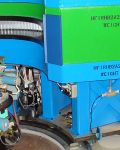Media Contact
Morgan McCorkle, Communications
mccorkleml@ornl.gov, 865.574.7308
OAK RIDGE, Tenn., June 7, 2016—An elusive massless particle could exist in a magnetic crystal structure, revealed by neutron and X-ray research from a team of scientists led by the Department of Energy’s Oak Ridge National Laboratory and the University of Tennessee.
In a paper published in Nature Communications, the research team studied a material containing the dense element osmium and documented two conditions required for the presence of Weyl fermions – massless particles predicted in 1929 and observed experimentally for the first time in 2015. Researchers are looking for other materials that could host the particles, with the goal of harnessing their unique properties in spintronics and advanced computing applications such as quantum computers.
“Once you have a material that hosts these particles, they can behave like electrons but travel much faster since they’re massless,” said ORNL’s Stuart Calder, first author on the team’s study. “Since all of electronics is based on the electron, if you replace electrons with these Weyl fermions, in principle you could have much faster devices.”
The scientists conducted neutron diffraction studies at the High Flux Isotope Reactor, a DOE Office of Science User Facility at ORNL, to clearly define the magnetic order of an osmium-based material with a pyrochlore crystalline structure. They discovered it has an “all-in, all-out” magnetic order—one of two requirements for this type of material to contain Weyl fermions.
“It describes the spins of electrons and how they arrange; they all either point to the center or they all point out,” Calder said. “Neutrons are the standard and the best way to determine magnetic structure. The magnetic peaks in these materials are weak because they have smaller sized spins, so you have to use an instrument like we have here to see them.”
Click here for the full story.







